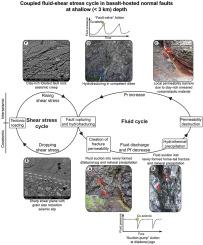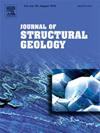冰岛 Húsavik 玄武岩中的正断层结构、演变和变形机制:对地热储层流体流动和地震的影响
IF 2.6
2区 地球科学
Q2 GEOSCIENCES, MULTIDISCIPLINARY
引用次数: 0
摘要
层状玄武岩序列中的断层对浅层地热储层中的热液流体流动以及二氧化碳封存过程中的潜在影响很大。然而,有关断层带结构、流体流动、变形机制和地震潜力的特征描述仍然不够完善。本研究针对这一空白,将结构和微观结构观测与 X 射线衍射分析相结合,对冰岛北部特约恩斯断裂带中地震活跃的胡萨维克-弗莱蒂断层相关的裸露正张性断层进行了分析。我们的研究结果表明,玄武岩基性正张性断层的演化经历了不同的阶段:(1) 从预先存在的冷却节理开始的低位移断层扩展;(2) 通过扩张性锯齿进行断层连接;(3) 通过角砾岩化和大塑性过程形成破坏带/断层核心;(4) 沿尖锐滑动面的剪切局部化;(5) 火山碎屑岩夹层沿主断层面的涂抹。剪切局部化、截断碎屑和热液角砾岩/岩脉的证据表明,超压流体促进了反复的地震滑动事件。相反,富含粘土的叶状钙钛矿的存在则表明在地震间歇期发生了非地震滑动。沿断层斜坡、弯曲、几何不规则和方位变化的滑动导致断层面扩张开裂,并在断层顶端产生延伸性马尾状断裂。这些结构在位于活动伸展-张拉构造环境中的浅层地热储层中形成了热液平行于断层走向横向移动的主表区。此外,扩张性锯齿和马尾状矿脉与承载断层的交汇处可能会形成与σ2古应力走向平行的线性高构造渗透率区和强烈的局部流体流动区,并最终形成矿物沉淀。这项研究的结果可用于改进地热流体流动模型,以提高玄武岩储层的采收率,并评估玄武岩断层的地震风险。本文章由计算机程序翻译,如有差异,请以英文原文为准。

Normal fault architecture, evolution, and deformation mechanisms in basalts, Húsavik, Iceland: Impact on fluid flow in geothermal reservoirs and seismicity
Faults within layered basaltic sequences significantly influence hydrothermal fluid flow in shallow geothermal reservoirs and potentially during CO2 sequestration and storage. Nevertheless, their characterization regarding fault zone architecture, fluid flow, deformation mechanisms, and seismic potential remains underdeveloped. This study addresses this gap by integrating structural and microstructural observations with X-ray diffraction analyses of exposed normal-transtensional faults associated with the seismically active Húsavík-Flatey Fault in the Tjörnes Fracture Zone, Northern Iceland. Our findings demonstrate that the evolution of basalt-hosted normal-transtensional faults progresses through distinct stages: (1) low-displacement fault propagation from pre-existing cooling joints; (2) fault linkage via dilational jogs; (3) damage zone/fault core growth through brecciation and cataclastic processes; (4) shear localization along sharp slip surfaces; and (5) smearing of volcaniclastic interbeds along the principal fault plane. Evidence of shear localization, truncated clasts, and hydrothermal breccias/veins suggests repeated seismic slip events facilitated by overpressured fluids. Conversely, the presence of clay-rich foliated cataclasite indicates aseismic slips during interseismic periods. Slip along fault jogs, bends, geometric irregularities, and orientation changes causes the dilatant opening of the fault planes and extensional horsetail fractures at fault tips. These structures create main tabular zones for lateral movement of hydrothermal fluids parallel to the fault strike in shallow geothermal reservoirs situated in active extensional-transtensional tectonic settings. In addition, the dilational jogs and the intersection of horsetail veins with the hosting faults may define linear zones of high structural permeability and intense localized fluid flow parallel to the σ2 paleostress orientation and finally mineral precipitation. The results of this study can be utilized to improve models of geothermal fluid flow for enhanced recovery in basaltic reservoirs and assess seismic risk in basaltic faults.
求助全文
通过发布文献求助,成功后即可免费获取论文全文。
去求助
来源期刊

Journal of Structural Geology
地学-地球科学综合
CiteScore
6.00
自引率
19.40%
发文量
192
审稿时长
15.7 weeks
期刊介绍:
The Journal of Structural Geology publishes process-oriented investigations about structural geology using appropriate combinations of analog and digital field data, seismic reflection data, satellite-derived data, geometric analysis, kinematic analysis, laboratory experiments, computer visualizations, and analogue or numerical modelling on all scales. Contributions are encouraged to draw perspectives from rheology, rock mechanics, geophysics,metamorphism, sedimentology, petroleum geology, economic geology, geodynamics, planetary geology, tectonics and neotectonics to provide a more powerful understanding of deformation processes and systems. Given the visual nature of the discipline, supplementary materials that portray the data and analysis in 3-D or quasi 3-D manners, including the use of videos, and/or graphical abstracts can significantly strengthen the impact of contributions.
 求助内容:
求助内容: 应助结果提醒方式:
应助结果提醒方式:


